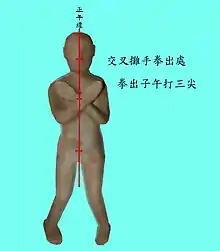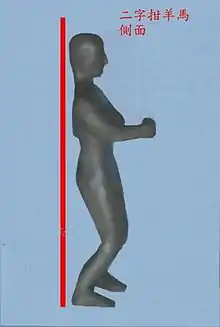Siu Nim Tao
Siu Nim Tao is the first open-hand form, or taolu, of Wing Chun kung fu. The name is a transcription of the Cantonese pronunciation of the Chinese characters "小念頭" (Pinyin: xiăo niàn tóu/Jyutping: siu2 nim6 tau4). Several other versions of the name are used by different organisations. The second form is called Chum Kiu.
| Siu Nim Tao | |||||||||||||
|---|---|---|---|---|---|---|---|---|---|---|---|---|---|
| Traditional Chinese | 小念頭 | ||||||||||||
| Simplified Chinese | 小念头 | ||||||||||||
| Literal meaning | little thought/idea | ||||||||||||
| |||||||||||||
Purposes
Siu Nim Tao can be used as a form of moving and breathing meditation. In addition, it increases student concentration and focus. The form is used extensively in Wing Chun.
Demonstrations of the form
Although many of the movements are similar, Siu Nim Tao varies significantly between schools and branches. In Ip Man’s Wing Chun Siu Nim Tao the first section of the form is done by training the basic power for the hand techniques by tensing and relaxing the arms.[1] In Moy Yat’s Wing Chun the first section of the form is done without muscle tension and slowly in a meditative, calm, and being “in the moment”.[2]
In 1972, weeks before he died, Ip Man demonstrated Siu Nim Tau on film on how the form is performed.[3] There is also a photo breakdown and captions on how each movement is correctly performed.[4]


References
- Knight, Dan (March 13, 2014). "Sil Lim Tao the first form". www.kwokwingchun.com. Retrieved 2019-01-23.
- "WING CHUN CONCEPTS: Siu Nim Tao". 2017-09-23. Archived from the original on 2017-09-23. Retrieved 2019-01-23.
- Philosophadam (2012-10-21), Grandmaster Ip Man Doing Sil Nim Tao (Normal and Slow Motion Speeds), retrieved 2019-02-12
- "Sil Lim Tao in the Wing Chun Syllabus". www.putneymartialarts.co.uk. Retrieved 2019-02-12.
- Siu Nim Tao - Sequence details Siu Nim Tau in photographs, shown courtesy of Marcelo Navarro, School Moy Yat Ving Tsun Kuen Europe.
External links
(Wayback Machine copy)